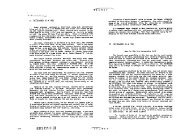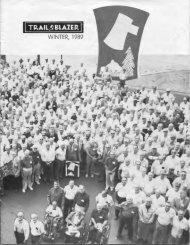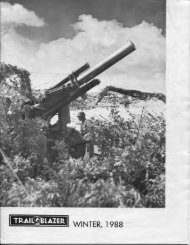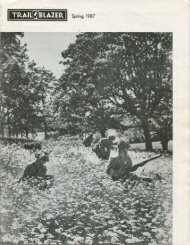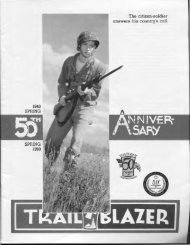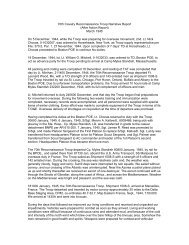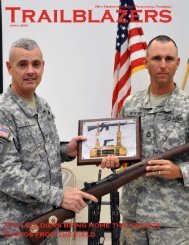Download - 70th Infantry Division Association
Download - 70th Infantry Division Association
Download - 70th Infantry Division Association
You also want an ePaper? Increase the reach of your titles
YUMPU automatically turns print PDFs into web optimized ePapers that Google loves.
In direct support of the Bloody Axe for the attack were the 884th Field Artillery Battalion reinforced by the<br />
495th AFA, the 86th Field Artillery Battalion and the Cannon Company of the 276th. Attached units were:<br />
One platoon, Company C, and one platoon, Company D, 749th Tank Battalion; one platoon, 2<strong>70th</strong><br />
Engineer Battalion, and Company C, 99th Chemical Battalion, minus one platoon.<br />
The enemy position, as the plans for the attack were completed, extended from Marienau through the<br />
town of Forbach, along the southwest edge of Le Kleinwaldchen, and through Oeting to Behren. S-2<br />
estimated enemy units in contact to have a strength of 520 men, divided among the First and Second<br />
Battalions of the 880th Regiment and the Second Battalion of the 860th Regiment.<br />
An estimated 800 reserves in Forbach, Stiring-Wendel were reported to have left, moving in the direction<br />
of Saarbrucken. S-2 pointed out that they might be reinforcing other units in the area. The food situation<br />
in Forbach, Stiring-Wendel and Marieneau was bad, and typhoid was reported in Stiring-Wendel.<br />
One possible enemy action in the event of a strong attack was foreseen as delay on successive positions<br />
until reaching the fortified area south of Saarbrucken, where a deliberate defense could be employed.<br />
Preparatory to the attack, a forward dump of K and C rations was established at Bening, and an<br />
emergency ammunition dump at Cocheren. Also at Cocheren was an emergency gasoline dump. On the<br />
eve of the attack Company G relieved Company I, Company H relieved elements of Company M,<br />
Company L relieved Company B, and Company M relieved elements of Company D in the Company L<br />
sector.<br />
The Second Battalion came under <strong>Division</strong> control, as <strong>Division</strong> reserve, when the attack started. Since<br />
Company G was in position on our left flank, our new left limiting point on a much-reduced front for the<br />
attack was in the woods northeast of Morsbach, while our right limiting point at the start of the attack was<br />
in the vicinity of Gaubivingen. This concentrated the efforts of the Bloody Axe initially on the Oeting<br />
vicinity.<br />
The day before the attack S-1 listed replacements required as eight officers and 160 enlisted men.<br />
At 0001 on 17 February the attack moved out, as scheduled, with the companies first advancing to<br />
assault positions, and from these locations launching the main attack just before daylight.<br />
Advancing through a heavy fog that made visibility extremely limited, Company K was on the left of the<br />
Third Battalion and Company I on the right; Company B on the left of the First Battalion and Company C<br />
on the right.<br />
Initial objective was the Kleinwald-Fahrbert-Kelsberg Hills. Pressing on against enemy small-arms fire, the<br />
Third Battalion had taken its part of the first objective by 0820 and was reorganizing. The First Battalion<br />
also reached its first goal and then Company B entered the town of Oeting, while Company C moved<br />
forward to the east of the town. B Company had barely gained a foothold in Oeting, and L Company on<br />
the left was preparing to enter, when the advancing troops came under the fire of four self-propelled 88's.<br />
So intense was this fire that L was unable to enter the city and B could push forward no farther. Meanwhile<br />
C Company was progressing very slowly because of heavy small-arms fire from an anti-tank ditch.<br />
Late in the day the intensity of the 88 fire compelled B Company to withdraw and dig in south of the town.<br />
At dark, Companies I and K, occupying the Third Battalion's initial objective, Company A to the southeast<br />
of Oeting, Company B to the south and Company C, east, were all digging in for an all-around defense for<br />
the night. Active patrolling was conducted throughout the night.<br />
The first day of the attack had revealed the deadly effectiveness of enemy land and antipersonnel mines,<br />
a number of casualties having resulted from these weapons. Enemy resistance throughout the day had<br />
been chiefly small arms fire, however. His artillery and mortar fire had been very light, except for the 88's<br />
in Oeting. An outstanding development of this initial day was the efficiency displayed by the units of the<br />
276th in maintaining contact with each other--a vast improvement over the situation in the attack<br />
conducted 6-7 February in the same general area. The day's casualties were one killed and 56 wounded.<br />
The 276th had taken 50 prisoners.



